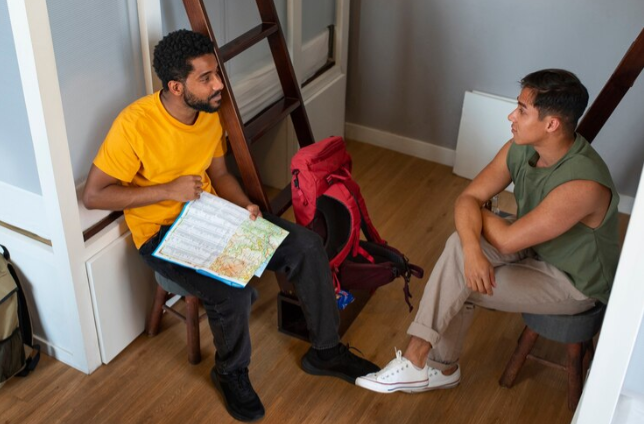Few things can transform a living space as dramatically as a fresh coat of paint. However, for those renting an apartment, the prospect of painting can be a daunting and confusing endeavour. Can you even paint the walls? What are the potential consequences? How do you go about getting permission? These are just a few of the questions that may arise.
As a professional residential painter with over a decade of experience in Sydney, I’ve encountered countless scenarios involving tenants looking to add their personal touch to a rented apartment through painting. It’s a tricky situation that requires a delicate balance between respecting the landlord’s property and satisfying the tenant’s desire for self-expression.
In this comprehensive guide, I’ll share invaluable insights and tips from my years of experience in the industry. We’ll explore the do’s and don’ts of painting your rented apartment, from understanding lease agreements and seeking landlord approval to proper preparation techniques and restoring the property to its original condition.
Whether you’re a seasoned renter or embarking on your first apartment painting adventure, this guide will equip you with the knowledge and practical advice you need to tackle this project successfully. So, let’s dive in and demystify the process of painting your rented abode!
Check Your Lease Agreement
Before you even think about cracking open that paint can, the first step is to review your lease agreement thoroughly. Most landlords have specific clauses addressing whether tenants can paint or alter the property. Violating these terms could lead to consequences like losing your security deposit or, worse, facing eviction.
As a general rule, it’s always best to assume that painting is not allowed unless explicitly stated otherwise in the lease. Even if it seems like a minor cosmetic change, your landlord may see it differently. So save yourself the headache and potential legal troubles by reading the fine print.
Seek the Landlord’s Approval
Alright, let’s say your lease doesn’t expressly prohibit painting. That’s great news, but you’re not clear yet! The next crucial step is to obtain written permission from your landlord or property manager.
When requesting, provide details on the areas you plan to paint and the colours you intend to use. It’s also a good idea to discuss your plan for restoring the walls to their original condition when you move out. Your landlord will likely appreciate your thoughtfulness and attention to detail.
Pro Tip: Consider offering high-quality, low-VOC (volatile organic compound) paints that are easier to cover up later. This small gesture can go a long way in getting your landlord’s approval.
Preparation is Key
Assuming you’ve gotten the green light from your landlord, it’s time to start prepping for your painting adventure! Proper preparation is crucial for achieving professional-looking results and avoiding potential property damage.
Here are some essential preparation steps:
- Protect surfaces: Cover floors, windows, fixtures, and other surfaces you don’t want painting with drop cloths or plastic sheeting.
- Clean the walls: Remove any dirt, grease, or loose paint by wiping down the walls with a degreaser or sugar soap solution.
- Repair any damage: Fill in cracks, holes, or dents with spackling compound and sand smooth once dry.
- Prime: Applying a coat of primer will help the new paint adhere better and provide a uniform base.
Don’t skimp on the prep work – trust me, it’ll make the actual painting process much smoother and ensure long-lasting results.
Painting Techniques for a Flawless Finish
Now for the fun part – the actual painting! As a professional painter, I can’t stress enough the importance of using the right techniques for a seamless, drip-free finish.
- Use high-quality brushes and rollers: Invest in good-quality tools to avoid leaving brush strokes or roller marks.
- Work in sections: Divide the room into manageable sections and complete one area at a time.
- Apply the paint properly: Start with the ceiling, move to the walls, and finish with the trim.
- Use painter’s tape: Apply tape along the edges and trim for clean, crisp lines.
- Consider using a paint sprayer: A paint sprayer can provide a smooth, even finish for larger areas or textured surfaces.
Remember, it’s all about taking time and applying the paint evenly and smoothly. Rushing through the process is a surefire way to end up with an amateurish, sloppy result.
Restoring the Apartment to Original Condition
Once you’ve successfully transformed your rental with a fresh coat of paint, the final step is restoring the apartment to its original condition before moving out. This crucial step ensures you get your full security deposit back and maintain a positive relationship with your landlord.
Here are some tips for restoring the walls:
- Use a high-quality primer: Apply a stain-blocking primer over the new paint to create a neutral base for the next coat.
- Match the original paint colour: Take a sample of the original wall colour to your local paint store and have them colour-match it.
- Apply multiple coats: Depending on the intensity of the new paint colour, you may need to apply two or three coats of the original colour to fully cover it.
- Consider hiring professionals: If you’re short on time or lack the necessary skills, hiring professional apartment painters to restore the walls may be worth the investment.
Remember, your landlord will likely inspect the property thoroughly before returning your security deposit. Taking the time to restore the walls properly can save you a significant amount of money in the long run.
Alternatives to Painting
Perhaps after weighing the pros and cons, you’ve decided that painting your rental isn’t the best option for you. Fear not, my friend! There are plenty of creative, commitment-free ways to add your personal touch to the space.
- Removable wallpaper: Peel-and-stick wallpaper is a great temporary solution that can instantly transform a room without damaging the walls.
- Wall decals: From inspirational quotes to intricate patterns, wall decals offer a fun and easy way to add visual interest.
- Gallery walls: Arrange framed art, photos, or mirrors in a visually appealing way to create a personalized gallery wall.
- Accent pieces: Incorporate colourful rugs, curtains, throw pillows, and other accent pieces to inject your style into the space.
The possibilities are endless when personalising your rental without causing permanent changes. Get creative and have fun with it!
Standard Apartment Paint Colors
Let’s talk about those standard apartment paint colours that seem ubiquitous in rental properties. You know, the ones – shades of white, off-white, and beige that can best be described as “builder’s bland.”
While these neutral hues may not be the most exciting, there’s actually a method behind the madness. Landlords and property managers often opt for these colours because they’re:
- Inoffensive: Neutral colours are less likely to clash with tenants’ styles and furniture.
- Easy to touch up: It’s simpler to match and touch up neutral colours when necessary.
- Appealing to a broader audience: When renting the property again, neutral walls have a wider appeal to potential tenants.
So, while you may be tempted to go bold and vibrant with your paint choices, remember that your landlord’s primary concern is maintaining the rental’s marketability for future tenants.
Painting Costs and Timelines
Ah, the age-old questions: “How much does it cost to paint an apartment?” and “How long will it take?” As a professional painter, I can tell you that the answers vary depending on several factors.
The cost of painting an apartment can range anywhere from a few hundred dollars for a studio apartment to several thousand for larger units, depending on:
- The size of the apartment
- The number of rooms and square footage
- The condition of the walls (repairs needed, texture, etc.)
- The quality of paint and materials used
- Whether you hire professional painters or do it yourself
Here’s a rough cost estimate for painting a two-bedroom apartment in Australia:
Service
Cost Range
Paint and Materials
$300 – $600
Labor (DIY)
$0
Labor (Professional Painters)
$1,200 – $2,400
As for timelines, a typical two-bedroom apartment can take 2-5 days to complete when hiring professionals. The duration depends on factors like the number of painters, the preparation work required, and the size and complexity of the job.
If you choose to tackle the project yourself, expect it to take significantly longer, potentially 1-2 weeks or more, depending on your experience level and the time you can dedicate to the task.
My advice? For larger projects or truly professional-grade results, strongly consider hiring experienced apartment painters. The investment can save you considerable time, effort, and frustration in the long run.





